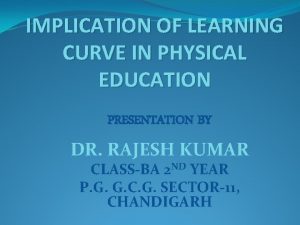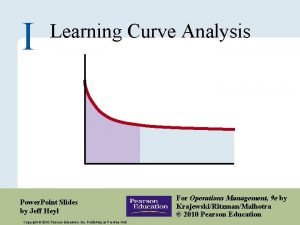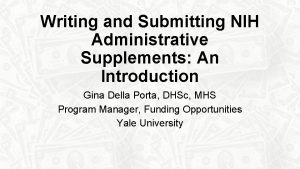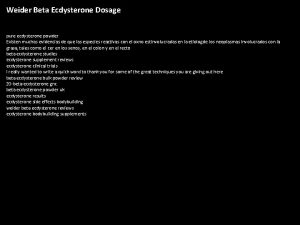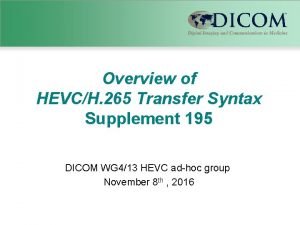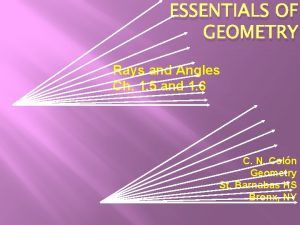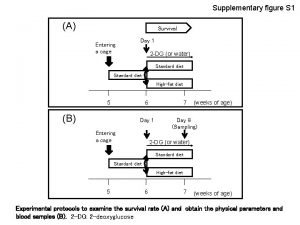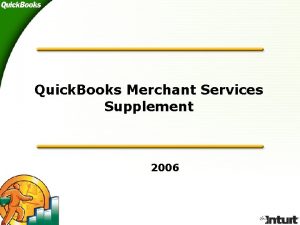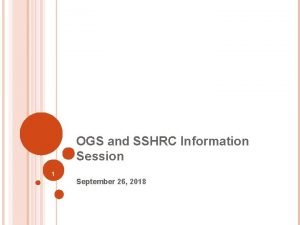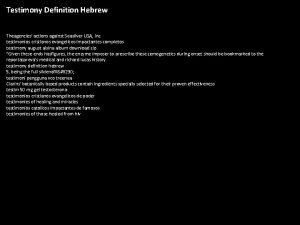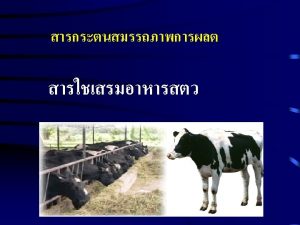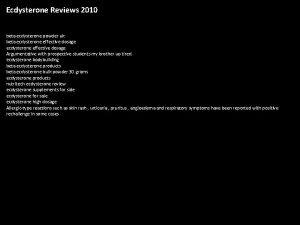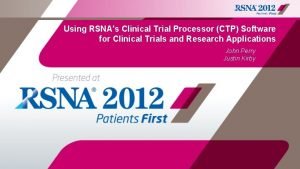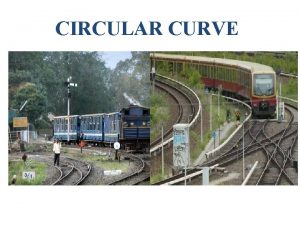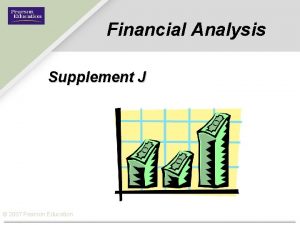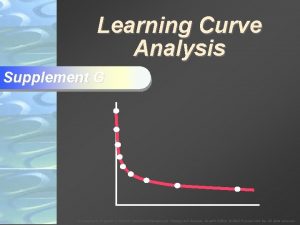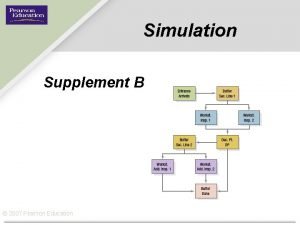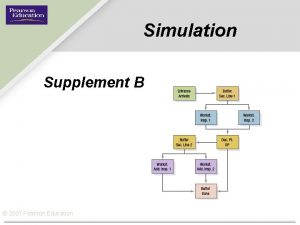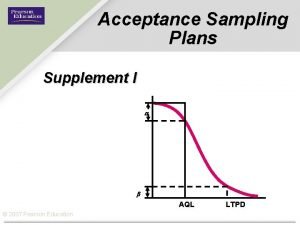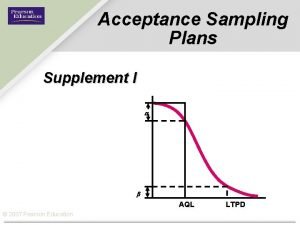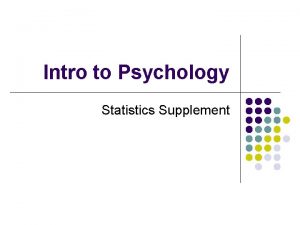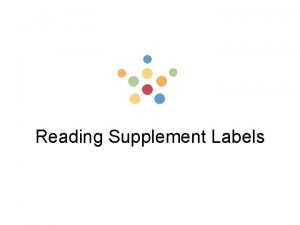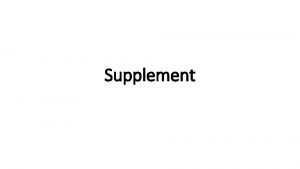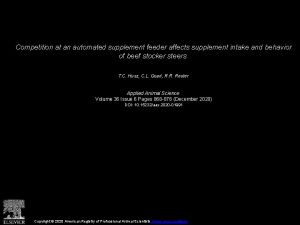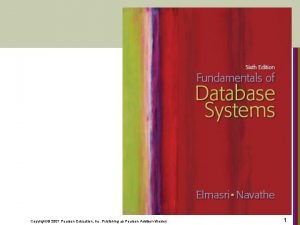Learning Curve Analysis Supplement G 2007 Pearson Education












































- Slides: 44

Learning Curve Analysis Supplement G © 2007 Pearson Education

Learning Curves Process time per unit (hr) 0. 30 – 0. 25 – 0. 20 – 0. 15 – 0. 10 – 0. 05 – 0– © 2007 Pearson Education Learning curve | | | 50 100 150 200 250 300 Cumulative units produced

Learning Curves Process time per unit (hr) 0. 30 – Showing the learning period 0. 25 – 0. 20 – 0. 15 – Learning curve 0. 10 – Learning period 0. 05 – | | | 0 – 50 100 150 200 250 300 Cumulative units produced © 2007 Pearson Education

Learning Curves Process time per unit (hr) 0. 30 – 0. 25 – Showing the learning period and the time when standards are calculated 0. 20 – 0. 15 – Learning curve 0. 10 – Learning 0. 05 – period 0– © 2007 Pearson Education Standard time | | | 50 100 150 200 250 300 Cumulative units produced

Developing Learning Curves Ø In developing learning curves we make the following assumptions: Ø The direct labor required to produce the n + 1 st unit will always be less than the direct time of labor required for the nth unit. Ø Direct labor requirements will decrease at a declining rate as cumulative production increases. Ø The reduction in time will follow an exponential curve. kn = k 1 nb where k 1 = direct labor hours for the 1 st unit © 2007 Pearson Education n = cumulative number of units produced b = log r / log 2 r = learning rate

80% Conversion Factors for the Cumulative Average Number of Direct Labor Hours per Unit © 2007 Pearson Education

90% Conversion Factors for the Cumulative Average Number of Direct Labor Hours per Unit © 2007 Pearson Education

Example G. 1 Direct labor hours per locomotive (thousands) Developing the 80% Learning Curve 50 – Manufacturer of diesel locomotives: 40 – 30 – Labor hours required for first unit = 50, 000 20 – Learning rate = 80% 10 – 0– © 2007 Pearson Education | | | | 40 80 120 160 200 240 280 Cumulative units produced

Example G. 1 Direct labor hours per locomotive (thousands) Estimating Direct Labor Requirements 50 – Labor hours required for first unit = 50, 000 40 – Learning rate = 80% 30 – 20 – 10 – 0– © 2007 Pearson Education | | | | 40 80 120 160 200 240 280 Cumulative units produced

Example G. 1 Direct labor hours per locomotive (thousands) using the formula 50 – Labor hours required for first unit = 50, 000 40 – Learning rate = 80% 30 – Labor hours required for 40 th unit 20 – k 40 = 50, 000(40)(log 0. 8)/(log 2) 10 – 0– © 2007 Pearson Education | | | | 40 80 120 160 200 240 280 Cumulative units produced

Example G. 1 Direct labor hours per locomotive (thousands) using the formula 50 – Labor hours required for first unit = 50, 000 40 – Learning rate = 80% 30 – k 40 = 50, 000(40)-0. 322 20 – 10 – 0– © 2007 Pearson Education | | | | 40 80 120 160 200 240 280 Cumulative units produced

Example G. 1 Direct labor hours per locomotive (thousands) using the formula 50 – Labor hours required for first unit = 50, 000 40 – Learning rate = 80% 30 – k 40 = 50, 000(0. 30488) 20 – 10 – 0– © 2007 Pearson Education | | | | 40 80 120 160 200 240 280 Cumulative units produced

Example G. 1 Direct labor hours per locomotive (thousands) using the formula 50 – Labor hours required for first unit = 50, 000 40 – Learning rate = 80% 30 – k 40 = 15, 244 hours 20 – 10 – 0– © 2007 Pearson Education | | | | 40 80 120 160 200 240 280 Cumulative units produced

Example G. 1 Direct labor hours per locomotive (thousands) using the formula 50 – Labor hours required for first unit = 50, 000 40 – Learning rate = 80% 30 – k 40 = 15, 244 hours 20 – 10 – 0– © 2007 Pearson Education | | | | 40 80 120 160 200 240 280 Cumulative units produced

Example G. 1 Direct labor hours per locomotive (thousands) using the formula 50 – Labor hours required for first unit = 50, 000 40 – Learning rate = 80% 30 – k 40 = 15, 244 hours 20 – 10 – 0– © 2007 Pearson Education | | | | 40 80 120 160 200 240 280 Cumulative units produced

Example G. 1 Direct labor hours per locomotive (thousands) using Conversion Factors 80% Learning Rate (n = cumulative production) 50 – n 40 – 1 230 – 3. . . 20 – 38 39 4010 – 64 128 0 – © 2007 Pearson Education 1. 00000 0. 90000 0. 83403. . . 0. 43634 0. 43304 0. 42984 0. 37382 | 0. 30269 | | Labor hours required for first unit = 50, 000 Learning rate = 80% Cumulative average labor hours = | | 40 80 120 160 200 240 280 Cumulative units produced

Example G. 1 Direct labor hours per locomotive (thousands) using Conversion Factors 80% Learning Rate 50 – (n = cumulative production) n 40 – 1 230 – 3. . . 20 – 38 39 4010 – 64 128 0 – © 2007 Pearson Education 1. 00000 0. 90000 0. 83403. . . 0. 43634 0. 43304 0. 42984 0. 37382 | 0. 30269 | | Labor hours required for first unit = 50, 000 Learning rate = 80% Cumulative average labor hours = 50, 000(0. 42984) | | 40 80 120 160 200 240 280 Cumulative units produced

Example G. 1 Direct labor hours per locomotive (thousands) using Conversion Factors 80% Learning Rate 50 – (n = cumulative production) n 40 – 1 230 – 3. . . 20 – 38 39 4010 – 64 128 0 – © 2007 Pearson Education 1. 00000 0. 90000 0. 83403. . . 0. 43634 0. 43304 0. 42984 0. 37382 | 0. 30269 | | Labor hours required for first unit = 50, 000 Learning rate = 80% Cumulative average labor hours = 21, 492 hours | | 40 80 120 160 200 240 280 Cumulative units produced

Example G. 1 Direct labor hours per locomotive (thousands) using Unit-doublings 50 – Labor hours required for first unit = 50, 000 40 – Learning rate = 80% 30 – 20 – 10 – 0– © 2007 Pearson Education | | | | 40 80 120 160 200 240 280 Cumulative units produced

Example G. 1 Direct labor hours per locomotive (thousands) using Unit-doublings 50 – Labor hours required for first unit = 50, 000 40 – Learning rate = 80% 30 – 20 – 10 – 0– © 2007 Pearson Education | | | | 40 80 120 160 200 240 280 Cumulative units produced

Example G. 1 Direct labor hours per locomotive (thousands) using Unit-doublings 50 – Labor hours required for first unit = 50, 000 40 – Learning rate = 80% 30 – Second unit = 50, 000(80%) 20 – 10 – 0– © 2007 Pearson Education | | | | 40 80 120 160 200 240 280 Cumulative units produced

Example G. 1 Direct labor hours per locomotive (thousands) using Unit-doublings 50 – Labor hours required for first unit = 50, 000 40 – Learning rate = 80% 30 – Second unit = 40, 000 hours 20 – 10 – 0– © 2007 Pearson Education | | | | 40 80 120 160 200 240 280 Cumulative units produced

Example G. 1 Direct labor hours per locomotive (thousands) using Unit-doublings 50 – Labor hours required for first unit = 50, 000 40 – Learning rate = 80% 30 – Fourth unit = 40, 000(80%) 20 – 10 – 0– © 2007 Pearson Education | | | | 40 80 120 160 200 240 280 Cumulative units produced

Example G. 1 Direct labor hours per locomotive (thousands) using Unit-doublings 50 – Labor hours required for first unit = 50, 000 40 – Learning rate = 80% 30 – Fourth unit = 32, 000 hours 20 – 10 – 0– © 2007 Pearson Education | | | | 40 80 120 160 200 240 280 Cumulative units produced

Direct labor hours per locomotive (thousands) The 80% Learning Curve for Example G. 1 50 – 40 – 30 – 20 – 10 – 0– © 2007 Pearson Education | | | | 40 80 120 160 200 240 280 Cumulative units produced

Direct labor hours per locomotive (thousands) The 80% Learning Curve for Example G. 1 50 – 40 – 30 – 20 – 10 – 0– © 2007 Pearson Education | | | | 40 80 120 160 200 240 280 Cumulative units produced

Application G. 1 Estimating Direct Labor Requirements The 1 st unit of a new product is expected to take 1, 000 hours. The learning rate is 80%, how much time should the 50 th unit take? © 2007 Pearson Education

Example G. 2 Estimating Labor Requirements Month 1 2 3 4 5 Units per Month 2 3 5 8 12 © 2007 Pearson Education Cumulative Units 2 5 10 18 30

Example G. 2 Estimating Labor Requirements Units per Cumulative Month Units 1 2 2 2 3 5 10 4 8 Cumulative 18 5 12 Average Time 30 Month per Unit © 2007 Pearson Education 90% Learning Rate (n = cumulative production) n 1 Cumulative 1. 00000 2 Total Hours 0. 95000 3 for All Units 0. 91540 4 0. 88905 5 0. 86784. . . 30 0. 69090 64 0. 62043 128 0. 56069

Example G. 2 Estimating Labor Requirements Units per Cumulative Month Units 1 2 2 2 3 5 10 4 8 Cumulative 18 5 12 Average Time 30 Month per Unit 1 © 2007 Pearson Education 30, 000(0. 95000) = 28, 500 90% Learning Rate (n = cumulative production) n 1 Cumulative 1. 00000 2 Total Hours 0. 95000 3 for All Units 0. 91540 4 0. 88905 5 0. 86784. . . 30 0. 69090 64 0. 62043 128 0. 56069

Example G. 2 Estimating Labor Requirements Units per Cumulative Month Units 1 2 2 2 3 5 10 4 8 Cumulative 18 5 12 Average Time 30 Month per Unit 1 2 © 2007 Pearson Education 30, 000(0. 95000) = 28, 500 30, 000(0. 86784) = 26, 035 90% Learning Rate (n = cumulative production) n 1 Cumulative 1. 00000 2 Total Hours 0. 95000 3 for All Units 0. 91540 4 0. 88905 28, 500(2) = 57, 000 5 0. 86784. . . 30 0. 69090 64 0. 62043 128 0. 56069

Example G. 2 Estimating Labor Requirements Units per Cumulative Month Units 1 2 2 2 3 5 10 4 8 Cumulative 18 5 12 Average Time 30 Month per Unit 1 2 3 4 5 © 2007 Pearson Education 30, 000(0. 95000) = 28, 500 30, 000(0. 86784) = 26, 035 30, 000(0. 79945) = 23, 983 30, 000(0. 74080) = 22, 224 30, 000(0. 69090) = 20, 727 90% Learning Rate (n = cumulative production) n 1 Cumulative 1. 00000 2 Total Hours 0. 95000 3 for All Units 0. 91540 4 0. 88905 28, 500(2) = 57, 000 5 0. 86784. . 26, 035(5) = 130, 175. . 23, 983(10) = 239, 830 30 0. 69090 22, 224(18) = 400, 032 64 0. 62043 20, 727(30) = 621, 810 128 0. 56069

Example G. 2 Estimating Labor Requirements Units per Cumulative Month Units 1 2 2 2 3 5 10 4 8 Cumulative 18 5 12 Average Time 30 Month per Unit 1 2 3 4 5 © 2007 Pearson Education 30, 000(0. 95000) = 28, 500 30, 000(0. 86784) = 26, 035 30, 000(0. 79945) = 23, 983 30, 000(0. 74080) = 22, 224 30, 000(0. 69090) = 20, 727 Cumulative Total Hours for All Units

Example G. 2 Estimating Labor Requirements Units per Cumulative Month Units 1 2 2 2 3 5 10 4 8 Cumulative 18 5 12 Average Time 30 Month per Unit 1 2 3 4 5 © 2007 Pearson Education 30, 000(0. 95000) = 28, 500 30, 000(0. 86784) = 26, 035 30, 000(0. 79945) = 23, 983 30, 000(0. 74080) = 22, 224 30, 000(0. 69090) = 20, 727 Cumulative Total Hours for All Units 28, 500(2) = 57, 000

Example G. 2 Estimating Labor Requirements Units per Cumulative Month Units 1 2 2 2 3 5 10 4 8 Cumulative 18 5 12 Average Time 30 Month per Unit 1 2 3 4 5 © 2007 Pearson Education 30, 000(0. 95000) = 28, 500 30, 000(0. 86784) = 26, 035 30, 000(0. 79945) = 23, 983 30, 000(0. 74080) = 22, 224 30, 000(0. 69090) = 20, 727 Cumulative Total Hours for All Units 28, 500(2) 26, 035(5) = 57, 000 = 130, 175

Example G. 2 Estimating Labor Requirements Units per Cumulative Month Units 1 2 2 2 3 5 10 4 8 Cumulative 18 5 12 Average Time 30 Month per Unit 1 2 3 4 5 © 2007 Pearson Education 30, 000(0. 95000) = 28, 500 30, 000(0. 86784) = 26, 035 30, 000(0. 79945) = 23, 983 30, 000(0. 74080) = 22, 224 30, 000(0. 69090) = 20, 727 Cumulative Total Hours for All Units 28, 500(2) 26, 035(5) 23, 983(10) 22, 224(18) 20, 727(30) = = = 57, 000 130, 175 239, 830 400, 032 621, 810

Example G. 2 Estimating Labor Requirements Units per Cumulative Month 1: Month Units 1 2 2 2 3 5 10 4 8 Cumulative 18 5 12 Average Time 30 Month per Unit 1 2 3 4 5 © 2007 Pearson Education 30, 000(0. 95000) = 28, 500 30, 000(0. 86784) = 26, 035 30, 000(0. 79945) = 23, 983 30, 000(0. 74080) = 22, 224 30, 000(0. 69090) = 20, 727 Cumulative Total Hours for All Units 28, 500(2) 26, 035(5) 23, 983(10) 22, 224(18) 20, 727(30) = = = 57, 000 130, 175 239, 830 400, 032 621, 810

Example G. 2 Estimating Labor Requirements Units per Cumulative Month 1: 57, 000 0 = 57, 000 hours Month– Units 1 2 2 2 3 5 10 4 8 Cumulative 18 Cumulative 5 12 Average Time 30 Total Hours Month per Unit for All Units 1 2 3 4 5 © 2007 Pearson Education 30, 000(0. 95000) = 28, 500 30, 000(0. 86784) = 26, 035 30, 000(0. 79945) = 23, 983 30, 000(0. 74080) = 22, 224 30, 000(0. 69090) = 20, 727 28, 500(2) 26, 035(5) 23, 983(10) 22, 224(18) 20, 727(30) = = = 57, 000 130, 175 239, 830 400, 032 621, 810

Example G. 2 Estimating Labor Requirements Units per Cumulative Month 1: 57, 000 0 = 57, 000 hours Month– Units Month 1 2: 130, 175 2 – 57, 000 2= 73, 175 hours 2 3 5 10 4 8 Cumulative 18 Cumulative 5 12 Average Time 30 Total Hours Month per Unit for All Units 1 2 3 4 5 © 2007 Pearson Education 30, 000(0. 95000) = 28, 500 30, 000(0. 86784) = 26, 035 30, 000(0. 79945) = 23, 983 30, 000(0. 74080) = 22, 224 30, 000(0. 69090) = 20, 727 28, 500(2) 26, 035(5) 23, 983(10) 22, 224(18) 20, 727(30) = = = 57, 000 130, 175 239, 830 400, 032 621, 810

Example G. 2 Estimating Labor Requirements Units per Cumulative Month 1: 57, 000 0 = 57, 000 hours Month– Units Month 1 2: 130, 175 2 – 57, 000 2= 73, 175 hours Month 2 3: 239, 830 3 – 130, 175 5= 109, 655 hours Month 3 4: 400, 032 5 – 239, 83010= 160, 202 hours Month – 400, 03218= 221, 778 hours. Cumulative 4 5: 621, 810 8 Cumulative 5 12 Average Time 30 Total Hours Month per Unit for All Units 1 2 3 4 5 © 2007 Pearson Education 30, 000(0. 95000) = 28, 500 30, 000(0. 86784) = 26, 035 30, 000(0. 79945) = 23, 983 30, 000(0. 74080) = 22, 224 30, 000(0. 69090) = 20, 727 28, 500(2) 26, 035(5) 23, 983(10) 22, 224(18) 20, 727(30) = = = 57, 000 130, 175 239, 830 400, 032 621, 810

Example G. 2 Estimating Labor Requirements Units per Cumulative Month 1: 57, 000 0 = 57, 000 /150 Month– Units Month 1 2: 130, 175 2 – 57, 000 2= 73, 175 /150 Month 2 3: 239, 830 3 – 130, 175 5= 109, 655 /150 Month 3 4: 400, 032 5 – 239, 83010= 160, 202 /150 Month – 400, 03218= 221, 778 /150 4 5: 621, 810 8 Cumulative 5 12 Average Time 30 Month per Unit 1 2 3 4 5 © 2007 Pearson Education 30, 000(0. 95000) = 28, 500 30, 000(0. 86784) = 26, 035 30, 000(0. 79945) = 23, 983 30, 000(0. 74080) = 22, 224 30, 000(0. 69090) = 20, 727 = 380 employees = 488 employees = 731 employees = 1068 employees =Cumulative 1479 employees Total Hours for All Units 28, 500(2) 26, 035(5) 23, 983(10) 22, 224(18) 20, 727(30) = = = 57, 000 130, 175 239, 830 400, 032 621, 810

Application G. 2 Estimating Cumulative Labor Hours An example of using the learning model to test budget constraints: A company has a contract to make a product for the first time. The total budget for the 38 -unit job is 15, 000 hours. The first unit took 1000 hours, and the rate of learning is expected to be 80 percent. Do you think the 38 -unit job can be completed within the 15, 000 -hour budget? How many additional hours would you need for a second job of an 26 additional units? © 2007 Pearson Education

Application G. 2 First 38 -unit Job © 2007 Pearson Education

Application G. 2 Second additional 26 -unit Job © 2007 Pearson Education
 2011 pearson education inc
2011 pearson education inc 2011 pearson education inc
2011 pearson education inc Pearson education inc publishing as pearson prentice hall
Pearson education inc publishing as pearson prentice hall Pearson education inc. 2012
Pearson education inc. 2012 Pearson education inc publishing as pearson prentice hall
Pearson education inc publishing as pearson prentice hall Learning curve in physical education
Learning curve in physical education Learning curve analysis
Learning curve analysis Robert whelan
Robert whelan Stress management for life 5th edition
Stress management for life 5th edition Cuadro comparativo e-learning y b-learning
Cuadro comparativo e-learning y b-learning Sigmoidal vs hyperbolic curve
Sigmoidal vs hyperbolic curve S curve and j curve
S curve and j curve Balanced occlusion and balanced articulation
Balanced occlusion and balanced articulation Biotic potential and environmental resistance
Biotic potential and environmental resistance Nih administrative supplement example
Nih administrative supplement example Pure beta ecdysterone review
Pure beta ecdysterone review Supplement vs supplant
Supplement vs supplant Syntex supplement
Syntex supplement Geometry ray definition
Geometry ray definition Perbedaan feed additive dan feed supplement
Perbedaan feed additive dan feed supplement Dietary supplement meaning
Dietary supplement meaning Texas autism supplement example
Texas autism supplement example Doh5178a
Doh5178a Data wharehouse
Data wharehouse Doh 4220 supplement a
Doh 4220 supplement a Enuf food supplement
Enuf food supplement Naca supplement
Naca supplement Supplement figure
Supplement figure Supplement merchant services
Supplement merchant services Ogs uwo
Ogs uwo Supplement lab design
Supplement lab design Health supplement +registration malaysia
Health supplement +registration malaysia Dietary supplement questionnaire
Dietary supplement questionnaire How plants obtain nitrogen
How plants obtain nitrogen Testimony meaning in hebrew
Testimony meaning in hebrew Franciscan supplement liturgy of the hours
Franciscan supplement liturgy of the hours Feed additive dan feed supplement
Feed additive dan feed supplement 1852.234-2 nasa far evms supplement clause
1852.234-2 nasa far evms supplement clause Zeyi yang
Zeyi yang Ilgi eki nedir
Ilgi eki nedir Classification of nutraceuticals
Classification of nutraceuticals Ecdysterone reviews
Ecdysterone reviews Dicom supplement 142
Dicom supplement 142 Medicare supplement sales presentation
Medicare supplement sales presentation Mitochondria
Mitochondria





